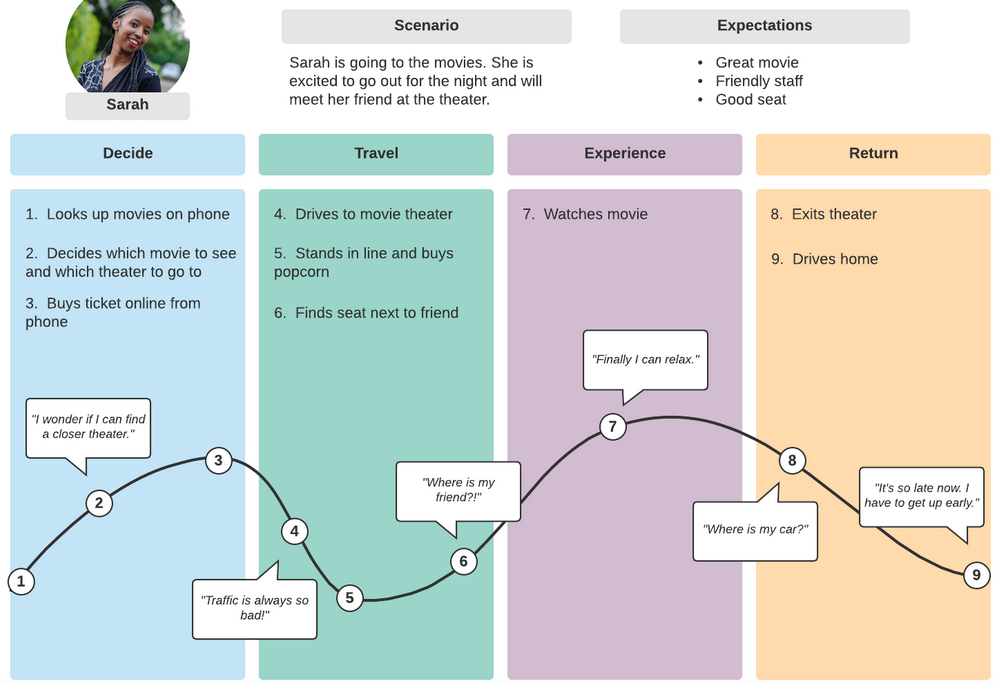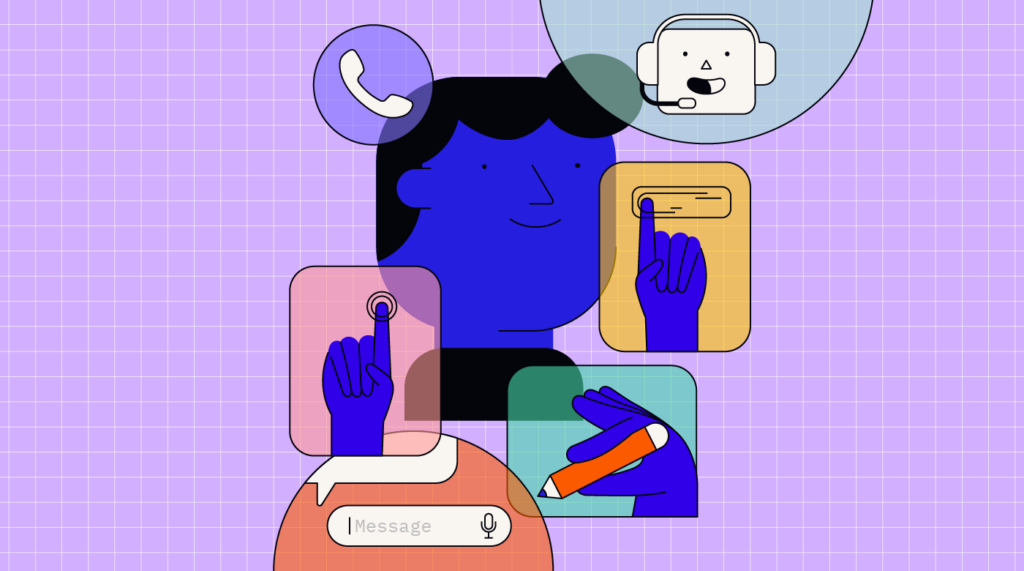Disney. Starbucks. Amazon. IKEA.
What's common with these huge brands, besides that they have become an essential part of your daily lives? Each one offers an experience that stays consistently superior every time you interact with them. Among their efforts to build a strong brand and customer-centric workforce culture, their ability to provide consistent customer experiences comes down to one big differentiator: great digital omnichannel experiences.
In this article, you will learn the steps you and your organization could take to create delightful omnichannel experiences. You would also learn how to transform your customer interactions to build offline channels and online experiences to create an omnichannel strategy to serve your customers in a brick-and-mortar store, contact center, or social media.
But first, let's understand what building a stellar digital omnichannel experience means for businesses, especially in a post-pandemic scenario.
What Are Digital Omnichannel Experiences?
Brands that offer multiple communication channels for customers use a multi-channel approach, i.e., they provide various touchpoints to their customers. For example, you might have talked to their sales team over the phone, used their mobile app or chatbot, or experienced their customer service inside actual stores. But these channels might not offer their customers the same consistent quality of experience. In addition, not all customers might use one of these channels frequently, so they might experience a difference between visiting a brand online and visiting them in-store.
This is where omnichannel experiences matter. Companies like the ones mentioned above build their brand experience into each channel they offer their customers across every stage of the customer journey. In a well-designed omnichannel experience, the quality of service and delight a customer might experience while evaluating a business before purchasing from them will remain constant long after they have become a customer, thus building long-term customer loyalty.
So where does the digital aspect of omnichannel experiences come in? In short, everywhere you interact with a brand, in today's post-pandemic scenario. According to a McKinsey report, buying behavior—especially in B2B decision making—has shifted to a virtual model, where customers prefer self-service channels during each phase of their lifecycle, from initial research and order to renewing annual agreements. This approach also meant that sales teams shifted from having a field presence to having more digital-enabled interactions, either as assisted selling or offering virtual options to new and existing customers.
What does that mean for you as a business decision-maker? First, you have to ensure that every time you show up to meet a customer online or offline, the experience that you serve online needs to match what they would experience in an offline store interaction too. And if you can match buying behavior to post-sales and loyalty behavior and serve that digital experience consistently, you will be enjoying much better customer retention rates and higher customer satisfaction scores. Conversely, you would have to fight hard to retain customers if this omnichannel experience is not done effectively since eight in ten B2B decision makers say they would actively look for options in these scenarios.
So how do you ensure that you intentionally develop and improve each of your digital channels for a stellar omnichannel experience? First, let's unpack all the steps.
6 Steps For A Digital Omnichannel Transformation Strategy
Step 1 - Create a customer journey map
The first step in your omnichannel transformation would be to map your customer journey, which visualizes all the milestones in your customer lifecycle as they interact with the multiple channels you have built for your business. Visualizing how each customer would interact with these channels like email, phone, call center, and in-store might take a while since you might have multiple customer personas. Segmenting your customer journeys by these personas would be crucial since each persona might interact with your business or brand differently, depending on their digital fluency. For example, customers who prefer a high-touch experience would choose to stay offline and may not use digital channels, so training your workforce to assist them with digital platforms would be necessary. On the other hand, digitally savvy customers (mainly digital natives born in the 2000s) might prefer digital channels only, so social media, mobile apps, and email might be the preferred mode of interaction.
Depending on the segment, your customer journey might look different. Nevertheless, knowledge is power, so understanding and building a shared knowledge of how your various customer segments interact with the digital channels you offer them is the first critical step in your strategy. Once you have built a customer journey map, it might look similar to this Lucidchart example.

Once you have plotted these customer interactions in your customer journey, the next step to evaluate the effectiveness of these channels, which are featured here, would be to build a service blueprint. The service blueprint allows your team to understand what it takes to make a customer interaction effective in a given channel.
For example, your customer might have called your contact center for an issue with their billing statement. Resolving this issue might take back-and-forth communication between multiple teams. If there is a significant time spent with the customer on hold during this resolution, the customer might experience frustration. Analyzing a pattern of long-drawn issue resolution scenarios with data, coupled with customer interviews, would help you identify and improve resolution times.
Many customer issues can span multiple channels, too, especially in a B2B workflow. For example, some customers might have a problem that started as a chatbot interaction, then shifted to a video call with a customer support agent, and eventually moved to email over several days until the issue was resolved. Mapping these service interactions across channels to understand how much time and effort is spent in resolving issues would help you investigate gaps in your customer experience.
Step 2 - Build your CRM to become your source of truth
Many businesses deploy and manage their CRM data only until the purchase interaction and do not integrate their care and loyalty programs with their CRM, thus leaving an opportunity to understand the post-purchase and loyalty aspects of the customer journey. Integrating your CRM, with customer activity, especially with customer support channels like mobile apps and chatbot agents, would help your team get a 360-degree view of the customer's pain points, thus enabling them to understand where a customer is experiencing frustration.
Once your team understands these pain points, they can anticipate what a customer might call in for, knowing their place in the customer journey map. Hence, a customer agent would be able to understand and be prepared to resolve a customer issue faster with valuable insights from knowing these data points beforehand.
Using best-of-breed customer experience management software could help you bridge the gap between your CRM and other systems your organization uses to serve customers across their journey. For reference, here's a list of the ten best customer experience management tools which can help you create a unified omnichannel approach.
Step 3 - Empower your team to understand your customer
Building the technology pieces of your CRM and data platforms might not be enough. You would also have to train your teams to understand your customer thoroughly. The shared knowledge should not be restricted to your marketing, sales, and customer support teams. On the contrary, it must be a mandate to build customer listening and engagement sessions for your product, engineering, and content design teams. If your IT and business teams are not in sync about their awareness of what the customer wants, they might not be able to build the right digital experience for them. Knowing where and how the customer interacts with the business would also help your leadership prioritize the proper funding and support to channels lagging in effective customer engagement.
Let's use the same example of a customer calling for a billing issue. If your digital teams work in silos and do not share the same insights about the customer, your mobile app teams might not be able to provide in-app support options for them to raise an online ticket. If the customer does not see an opportunity to submit a ticket through the app, they inadvertently will resort to calling the contact center for a simple issue, which could have been resolved over email. Such cases at scale might increase the cost of operating high-touch channels like the contact center while taking away from adopting self-serve channels like mobile apps effectively.
Step 4 - Automate key processes for self-serve channels
The next step in your digital omnichannel strategy would be to automate low-value, high-impact interactions, especially across your self-serve channels. For example, customer issues, especially for mundane tasks like password resets or billing queries, could be seamlessly routed to a mix of chatbots and knowledge-base questions. A well-designed knowledge base, coupled with an intuitive user experience to resolve account access queries, can reduce issue resolution volume and help you divert the energy of your customer-facing teams to the pain areas, requiring more resources.
Building a stellar omnichannel customer service blended into your digital channels is considered a pipe dream, so we compiled the best resources for implementing an effective customer service channel to help you realize that with optimal effort.
Step 5 - Put the 'care' back into your customer care journey
Lastly, training your workforce to lead with empathy would be the most differentiating factor for building a stellar digital omnichannel experience. The warmth and delight a customer might experience in an in-person interaction inside a physical store might be hard to replicate using a chat pop-up or a mobile notification. A mix of practical consumer psychology, user experience patterns, and robust functionality built into your mobile apps and website would help your customers experience the same delight and warmth in their digital interactions.
This is where great content and copy could help you bridge the gap between physical and online experiences and replicate the same brand voice in digital e-commerce and self-serve channels. By leading with empathy, brands like Starbucks can bring the mobile ordering experience to the same level as ordering a coffee in a Starbucks store would.
Step 6 - Build a digital feedback loop
You might already be measuring your customer interactions' NPS scores and satisfaction levels, but are you measuring it across different channels? Building a feedback system across your digital channels using monitoring tools can help you understand which channels are failing to deliver the brand experience. Then, when you mix them with the right blend of customer interviews and surveys to dive deeper into your areas of improvement, you can uncover and seed new opportunities in your product backlog. You would also be able to resolve issues across your technology ecosystem.
For example, let’s say that your chatbot or live agent chats are spending longer issue resolution times because the issue management system takes a while to return the activity history for a given customer. Improving the back-end performance and deploying hardware and performance fixes would help you improve your issue management system for chat-based channels and mobile apps, which use the same system behind the scenes.
Need expert help selecting the right Digital Shelf Analytics Software?
If you’re struggling to choose the right software, let us help you. Just share your needs in the form below and you’ll get free access to our dedicated software advisors who match and connect you with the best vendors for your needs.
Conclusion: Every Improvement Counts
Improving all your digital channels to build a practical omnichannel experience might be hard at first, and it might take considerable time and resources to get it right. But small steps in improving each digital channel would build a flywheel effect for your business. Once these six steps are put into place to enhance customer interactions continuously, you would experience the customers will not just stick with your brand for longer - They will bring more customers and subscribers to your business.
If you liked this article and would like to read more topics about building great customer experiences, don’t forget to subscribe to our newsletter!



